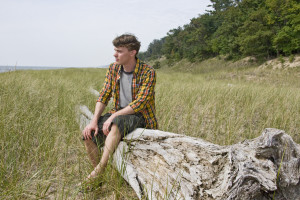The cawing of the crows kept growing in volume with periodic intense outbursts as more joined in from the surrounding woodland. I looked down the hillside at the huge ancient oak tree sitting in the middle of my Grandpa’s farm field. What was that mammoth tree hiding beneath its leaves? Why where the crows gathering there? Were they making noise simply because they were being crows or was there another reason? To see signs and clues in nature, you need to approach life like a child and ask “why?” Children are often the perfect beginner science and nature explorers. “Why”, you ask? Well, you’re already off to a good start.

Image credit Jessica Smith
The idea of teaching your child about science and nature may seem daunting. Some may say: “You don’t have a degree in science. You’re not a certified teacher. How are you properly equipped to teach your child about the natural sciences, like ecology?” Before you get too stressed out, let’s define our terms. The study of ecology focuses on how animals and plants live within a web of life in the natural world. It might be helpful to visualize ecology as a five-tiered pyramid of learning. Going from the bottom to the top, you have levels that are descriptive, comparative, causal, experimental, and theoretical. In plain English – you observe and describe what you see, then you compare notes, then you ask why, then you perform experiments to answer your questions, and then you form hypotheses based on your results. This is a natural progression of learning that your child is already equipped to follow. You don’t need a PhD to help your child learn about nature – you just need to point the way.
The bottom two tiers of the ecology pyramid (descriptive and comparative) are where children start – in the realm of what is called natural history. Explorers Lewis and Clark, bird expert John James Audubon, and nature author/artist William Bartram were all early American naturalists (with no science degrees) who observed and described what they saw. Observation and description are the foundational bases of the natural sciences and they are exactly what children naturally do. What does it look like? How does it feel? Where did you find it? You don’t need a degree to look at the world around you and write down or draw what you observe and experience. That’s the beauty of engaging with God’s creation – it’s here for everyone to experience, study, and ponder. No prerequisites, other than a thirst to learn about what the hand of God has crafted.
So what does this all mean in practical terms? Or as my pastor would have said: “let’s put this in shoe leather.” Whether or not your child decides to explore all the levels of the ecology pyramid with experiments and theories, is up to them. Your responsibility is simply to get them started, by appreciating the natural world that God has given us. Nurture their natural curiosity to observe, describe, and ask why. As spring comes again this year, there are many opportunities for you to do this with your family. What you do will depend on the ages of your children and your family’s preferences, but here are some suggestions to get you started…
Stump-sitting:
 Go outside and find a quiet area without distractions. Find a stump or a log to sit on (or bring a portable camp chair). Have a seat and watch, listen, and smell. Set a specific time that you will remain seated without talking. Take notes or draw pictures. Make it a game. How many things do you see and hear? This is a great activity to help children learn to see (a.k.a. observe). It also is calming and is a break from all the media stimuli our young people are subjected to by our culture. Author Charles Fergus jokingly suggested that stump-sitting should be a civil requirement. Everyone, he said, should sit out in nature and be quiet for at least one hour each year. Your family should give it a try this spring.
Go outside and find a quiet area without distractions. Find a stump or a log to sit on (or bring a portable camp chair). Have a seat and watch, listen, and smell. Set a specific time that you will remain seated without talking. Take notes or draw pictures. Make it a game. How many things do you see and hear? This is a great activity to help children learn to see (a.k.a. observe). It also is calming and is a break from all the media stimuli our young people are subjected to by our culture. Author Charles Fergus jokingly suggested that stump-sitting should be a civil requirement. Everyone, he said, should sit out in nature and be quiet for at least one hour each year. Your family should give it a try this spring.
Log-flipping:
You can do this activity with any age child. It’s one of my favorite pastimes! Head out onto a wooded trail and scan the forest floor for old fallen logs and branches. You are looking for logs that have lain long enough to create a small habitat underneath. They have to be big enough and old enough to protect a small area of moist soil, where many little creatures can live and hide from the hot sun. Roly-polies, millipedes, ground beetles, ants, slugs, and salamanders love these dark and damp homes. It’s like discovering secret treasure – you never know what you’ll uncover. Sometimes not much, but other times you strike gold! This activity helps children describe which logs have more creatures underneath and ask why that would be true. Just remember what my nature mentor John Acorn reminds us – always keep the one rule of log-flipping: put the log back just as you found it when you are done. This preserves the small habitat after you have moved on.
Backyard Habitat Program:
 How would you like to have your backyard certified as an official wildlife habitat? Well, you can. The National Wildlife Federation has a fun program that allows you to do this. They have an online step-by-step program that walks you through all the elements a wildlife habitat needs. Once you have identified all the aspects necessary to provide food, water, shelter, and a place to raise young – you can certify your yard and order a small sign if you wish. This exercise helps children learn about habitats and what they need to provide wildlife. If your yard does not have all it needs for certification, maybe you can add some elements to make your yard more diverse. This activity helps your family recognize that your yard is a place where animals live and that you can help care for them. Go online here to find out more.
How would you like to have your backyard certified as an official wildlife habitat? Well, you can. The National Wildlife Federation has a fun program that allows you to do this. They have an online step-by-step program that walks you through all the elements a wildlife habitat needs. Once you have identified all the aspects necessary to provide food, water, shelter, and a place to raise young – you can certify your yard and order a small sign if you wish. This exercise helps children learn about habitats and what they need to provide wildlife. If your yard does not have all it needs for certification, maybe you can add some elements to make your yard more diverse. This activity helps your family recognize that your yard is a place where animals live and that you can help care for them. Go online here to find out more.
Green Hour Challenge:
Research shows that children are happier and healthier in all aspects, when they spend time outside in a green space on a regular basis. What is a “green space”? It could be a garden, a backyard, a park down the street, or anyplace that surrounds your child with trees, plants, and wildlife. The connection between being healthier and being outside is only natural, since God designed nature to rejuvenate us. The National Wildlife Federation has created an online Green Hour resource, encouraging parents to have their children spend at least one hour outside each day. The goal is to allow children to truly play – not play a video game. It’s important for children to have periods of unstructured play, where imagination can thrive, and the mind can create. The Green Hour site has an “Activity Finder” with ideas to help you get started and guide you. Go online here to get more information.
Back in my Grandpa’s farm field that day, I was observing all I could about the crows. I was asking questions about their behavior. Based on my past observations in different places, I knew that they had cornered an owl during daylight hours and were mobbing it. Moments later I saw a huge Great-horned Owl fly out of the tree amidst harsh cawing. It headed into the woods. I tracked it across the woodlands and a swamp, before getting down on my stomach for a military crawl to get beneath it in a thick stand of pines. Around me on the ground were owl pellets – indicating that this was a frequent resting spot for this owl. I made some valuable observations about owls that day that have served me well. One afternoon in nature can hold adventures you will never forget.
I challenge you to go beyond your doorstep and have some nature adventures with your family. You don’t need a degree and you don’t need to be someplace exotic to experience nature in intimate and amazing ways. Take your family on a canoe ride down a local river, stump-sit in a state park, or revitalize your backyard for wildlife. Let’s take a closer look at what’s around us and adopt the outlook of Louis Agassiz, who said: “I spent the summer traveling; I got half-way across my backyard.”






 They stand stark and tall after the blaze of color has passed. Remnant embers, however, still burn across the hillsides, down the valleys, and along the roadsides. These vestiges of autumn’s past glory glow with the warmth that will keep us through the months to come. The yellows of firelight, the reds of cranberry sauce, the burgundy of plum pudding, and the oranges of pumpkin pie fill our eyes and hearts with delight. These blessings of the harvest feed our bodies and our souls in God’s perfect timing. Just as the warmth of Indian summer leaves us, firelight and friends warm us indoors. When the sweet smells of nature are masked by the cut of bitter winds, wonderful aromas waft from the kitchen.
They stand stark and tall after the blaze of color has passed. Remnant embers, however, still burn across the hillsides, down the valleys, and along the roadsides. These vestiges of autumn’s past glory glow with the warmth that will keep us through the months to come. The yellows of firelight, the reds of cranberry sauce, the burgundy of plum pudding, and the oranges of pumpkin pie fill our eyes and hearts with delight. These blessings of the harvest feed our bodies and our souls in God’s perfect timing. Just as the warmth of Indian summer leaves us, firelight and friends warm us indoors. When the sweet smells of nature are masked by the cut of bitter winds, wonderful aromas waft from the kitchen.
